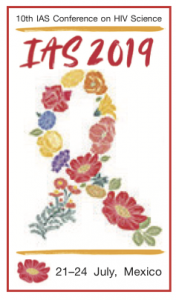First viral load results for capsid inhibitor GS-6207: mean –2.2 log reduction at day 10
24 July 2019. Related: Conference reports, Antiretrovirals, IAS 10 Mexico City 2019.
 Simon Collins, HIV i-Base
Simon Collins, HIV i-Base
The IAS 2019 conference includes several presentations with new results on pipeline compounds, including the first viral efficacy results in HIV positive people with the capsid inhibitor GS-6207. [1]
Until now, the only in vivo data with this new compound were single-dose safety and tolerability results presented at CROI 2019 earlier this year. Of note, this study reported possible multiple mechanisms of action and the feasibility for this molecule to have an extended release formulation, given the compound is detectable six months after a single dose. [2]
The new results are from an ongoing double-blind placebo-controlled dose-finding phase 1b study in 24 HIV positive participants (22 men, 2 women) who were either treatment-naive or who had used ART for <12 weeks.
Participants were randomised 3:1 (n=8 per group) to a single sub-cutaneous dose of GS-6207 (20, 50, 150, 450, or 750 mg) or placebo. The primary endpoint was viral load reduction at day 10, when all participants started triple-ART with bictegravir/emtricitabine/tenofovir alafenamide (B/F/TAF).
Other baseline characteristics included median (range) CD4 and viral load of 442 cells/mm3 (340 to 661) and 4.48 log copies/mL (4.3 to 4.6), respectively. Ethnicity included 58% white, 33% black and 4% Asian. Median BMI was 25 kg/m2 (range: 20 to 34).
Viral load results included mean reductions in viral load for the 50 mg, 150 mg and 450 mg doses of –1.8, –1,8 and –2.2 log copies/mL respectively, with maximum viral load reductions of –2.4, –2.1 and –2.9 respectively. See Table 1.
No serious adverse events were reported, including no grade 3 or 4 side effects or laboratory abnormalities.
Plasma levels of GS-6207 at day 10 remained above the protein adjusted IC95 for all doses.
A second poster at IAS 2019 confirmed the susceptibility to drug resistance from in vitro passaging studies, which occurred more slowly than efavirenz or elvitegravir but which still generated high level resistance. Early mutations at N74D in capsid led to 5.3 fold reduced sensitivity but this increased to >100-fold with later development of N74D + Q57H. These are apparently highly conserved regions of capsid and have some impact on viral fitness. [3]
Both studies concluded that these early data support further evaluation of GS-6207 as a long-acting antiretroviral for treatment of HIV.
Table 1: Viral load responses at day 10 following single dose of GS-6207
| VL reduction, log copies/mL | 50 mg, n=6 | 150 mg, n=6 | 450 mg, n=6 | Placebo, n=6 |
| Mean | –1.8 | –1.8 | –2.2 | –0.2 |
| 95% CI | (–2.3, –1.3) | (–2.0, –1.6) | (–2.7, –1.7) | (–0.4, –0.1) |
| Median (Q1, Q3) |
–1.7 (–1.2, –1.6) |
–1.8 (–1.9, –1.6) |
–2.2 (–2.5, –1.8) |
–0.2 (–0.3, –0.1) |
| Min, max | –2.4, –1.2 | –2.1, –1.5 | –2.9, –1.6 | –0.4, –0.1 |
comment
These are impressive early results, especially given the potential for a new long-acting formulation.
Details of other pipeline HIV drugs in development, including studies to watch for at IAS 2019, are included in the i-Base 2019 pipeline report, now online. [4]
References
- Daar ES et al. Safety and antiviral activity over 10 days following a single dose of subcutaneous GS-6207, a first-in-class, long-acting HIV capsid inhibitor in people living with HIV. 10th IAS Conference on HIV Science (IAS 2019), 21-24 July 2019, Mexico City. Late breaker poster abstract. LBPEB13.
http://programme.ias2019.org/Abstract/Abstract/4906 - Sage JE et al. Safety and PK of subcutaneous GS-6207, a novel HIV-1 capsid inhibitor. CROI 2019, oral abstract 141.
http://www.croiconference.org/sessions/safety-and-pk-subcutaneous-gs-6207-novel-hiv-1-capsid-inhibitor - Yant SR et al. In vitro resistance profile of GS-6207, a first-in-class picomolar HIV capsid inhibitor in clinical development as a novel long-acting antiretroviral agent. 10th IAS Conference on HIV Science (IAS 2019), 21-24 July 2019, Mexico City. Poster abstract TUPEA075.
http://programme.ias2019.org/Abstract/Abstract/683 - i-Base. HIV pipleine report (2019), July 2019.
https://i-base.info/htb/36278

